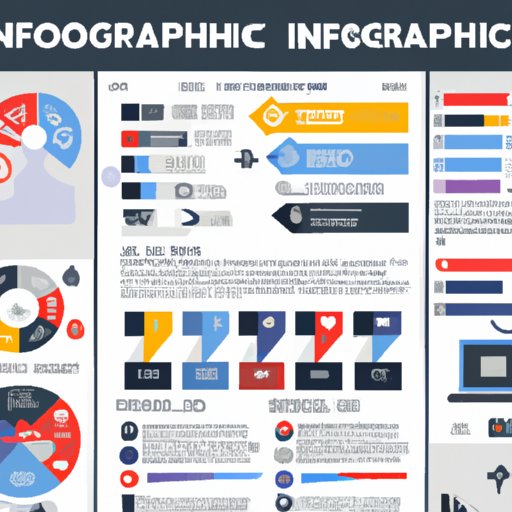
Creating an Infographic: A Step-by-Step Guide
Infographics have become a popular tool for communicating complex information in a visual and engaging manner. Whether you are creating an infographic for a presentation, a report, or for social media, a well-designed and informative infographic can make a big impact. In this article, we will provide you with a step-by-step guide to creating an effective infographic, as well as design tips and tricks, tools and resources, and examples of successful infographics.
Step-by-Step Guide
Before diving into the design process, it is important to plan and select the data you want to include in your infographic. This will help you avoid clutter and ensure that your infographic communicates a clear message. Here are the steps to create an infographic:
1. Brainstorming and Researching
Start by brainstorming the topic or subject you want to communicate through your infographic. Research relevant data and information, and identify potential sources to support your ideas. This will help you narrow down your focus and identify the most important information to include in your infographic.
2. Outlining and Organizing
Once you have your data, organize it in a logical and cohesive manner to communicate your message effectively. Outline the key points you want to make in your infographic, and think about how you can use visuals to supplement your data.
3. Choosing a Layout and Design
Choose a layout and design that best suits your data and message. Consider the size and orientation of your infographic, as well as the type of design elements you want to use such as icons, images, and typography.
4. Collecting and Analyzing Data
Collect your data and analyze it for accuracy and relevance. Ensure that you have cited your sources, and fact-checked your data before finalizing your infographic.
5. Building and Refining the Infographic
Build your infographic using design software or a template. Refine your infographic by playing with colors, typography, placement, and size of elements. Make sure to proofread your infographic and have others review it before finalizing.
Throughout each stage of creating an infographic, there are tips and tricks that can help you make an effective and visually appealing infographic. Here are a few:
- Use simple and clear language that your target audience can easily understand
- Keep your design clean and uncluttered
- Use icons to represent complex ideas or data
- Choose a font that is readable and fits the style of your design
- Use contrasting colors to create visual interest and emphasize key points
Design Tips and Tricks
A well-designed infographic combines visual appeal with effective communication. Here are some design tips and tricks to help you create a balanced and visually appealing layout:
1. Choosing a Color Palette
Choose a color palette that is visually appealing and communicates the mood and tone of your message. Use color contrast and saturation to emphasize key elements and data points.
2. Using Typography Effectively
Typography is an important aspect of infographic design. Choose fonts that are readable and consistent with your branding. Use different font sizes and styles to create interest and hierarchy in your design.
3. Creating a Balanced and Visually Appealing Layout
A balanced layout is essential for effective communication. Use grids, alignment, and white space to create balance and hierarchy in your design. Make sure to leave enough space between elements to avoid clutter.
These tips can help you create a visually appealing infographic that communicates your message effectively. But where can you find tools and resources to help you design your infographic?
Tools and Resources
There are several tools and resources available to help you create an infographic:
1. Free Templates and Icons
Free templates and icons are available online and can provide a great starting point for your infographic. Some popular online resources include Canva, Piktochart, and Venngage.
2. Paid Software and Design Tools
For those willing to invest in their infographic design, paid software such as Adobe Illustrator and InDesign are popular options. These programs offer more advanced design capabilities and features.
3. Data Visualization Tools
Data visualization tools are useful for rendering complex data in a more easily understandable format. Tools such as Tableau and Datawrapper are popular options.
When choosing a tool or resource to help you with your infographic, consider the complexity of your data, your design skills, and your budget.
Examples and Case Studies
Looking at examples of successful infographics can help you understand what makes an effective infographic. Here are some examples:
- The Daily Routines of Creative Geniuses
- The Anatomy of a Perfect Web Page
- The Best Times to Post on Social Media
These examples showcase effective use of icons, typography, and color. They also communicate their message in a clear and engaging manner.
By analyzing these examples and identifying best practices, you can better understand how to create your own effective infographic.
Infographic Trends and Innovations
The world of infographics is constantly changing, with new trends and innovations emerging every year. Here are a few current trends to keep in mind:
- The use of animation and motion graphics in infographics
- The increase in interactive and responsive web-based infographics
- The use of augmented and virtual reality to enhance the user experience
As technology and design capabilities continue to evolve, we can expect continued innovation in the world of infographics.
Conclusion
Creating an infographic requires careful planning and consideration. By following our step-by-step guide, incorporating design tips and tricks, and utilizing online resources, you can create an effective infographic that communicates your message in an engaging way. Remember to stay up-to-date on new trends and innovations in the world of infographics, and don’t be afraid to experiment to find what works best for your message.





